The Story Behind Back To The Future
Back to the future and beyond…
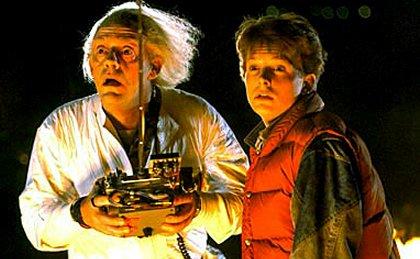
A video pirate hero, a refrigerator time machine and a Nevada atomic explosion. Ah, what so nearly could have been.
When producer Bob Gale and writer/director Robert Zemeckis first dreamed up their concept of a time-travelling 17-year-old who hops decades and meets his parents as teenagers, the phrase ‘tricky first draft’ springs to mind.
Luckily, the final print of their trend-setting and imminently quotable dramedy became – somewhat ironically – a timeless classic when it was released in 1985.
This year, Back To The Future blasts back onto the big screen, a befuddling 25 years after it first introduced us to Doc Brown, Marty McFly, and the wacky, history-flirting world they inhabit.
But as Marty quickly discovers in his adventures, the course of history never did run smooth. Mass studio rejection and three years of fruitless peddling lay ahead of Gale and Zemeckis when they penned their first draft of the script in 1981.
How did it ever get made? Let’s go back to, well, you know…
Next: 1980 - "Great Scott!" [page-break]
1980 – “Great Scott!”
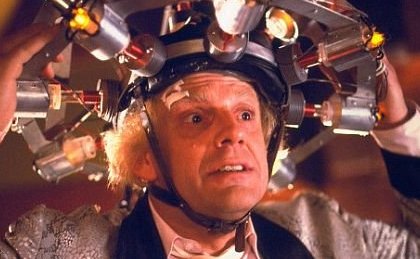
They say ‘write what you know’, and Back To The Future is a fine filmic example of that.
Not because Bob Gale or Robert Zemeckis had actually ever travelled through time and found themselves trapped in an oedipal nightmare. But because the germ of the idea behind Back To The Future budded from a very realistic, human place.
“Bob and I had always wanted to do a time travel movie,” says producer Gale. The pair, who had worked previously on comedies I Wanna Hold Your Hand and Used Cars , didn’t happen upon an idea that they both liked until Gale took a trip back to his parents’ home in the summer of 1980.
“I found my father's high school yearbook,” he says. “He'd been president of his graduating class. I thought about the president of my graduating class, who was someone I'd never have anything to do with, and I started thinking.
“When he was in high school, was my dad one of these rah-rah, school spirit kind of guys that I couldn't stand? And what would have happened if I'd gone to high school with my dad - would I have had anything to do with him or not? The secret of doing this time travel movie was not having an adult go back in time but having a kid go back.”
When Gale returned to Los Angeles, he shoved the idea Zemeckis’ way. Catching on immediately, the director made a wisecrack about what Gale’s mother might have been like at high school… and BTTF was born.

Zemeckis counts himself as a big fan of time travel movies because they accomplish what cinema should always achieve – making our wildest fantasies into a tangible reality on-screen.
“Time travel has always been fascinating because it’s something that I think we all fantasise a little bit about and that makes it really interesting,” the director says. “When I started studying film I realised that telling a time travel story in a movie lends itself to that probably better than any medium.”
Getting to work, Gale and Zemeckis approached Columbia Pictures with their idea for the film, and quickly signed a development deal.
Together, the filmmakers began fleshing out a script that transported 17-year-old '80s hero Marty McFly back to 1955 – an era chosen not for its supposed nostalgic value, but because the ages of the characters, specifically Marty’s teenage parents, required that he travel that far back.
By a happy coincidence, the ‘50s also worked on a thematic level, that era giving birth that terrible and most featured of creatures – the teenager.
“The ‘50s was the time that the birth of the teenager happened anyway,” Zemeckis explains, “teenagers in America were given power; power by the media, power to buy things, they became an economic power. So that worked out well for us.”
The first draft of the script pitched Marty as a video pirate instead of a wannabe rock star, while the time travel MacGuffin presented itself in the form of a bog standard kitchen fridge…
Next: 1981 - "If you put your mind to it, you can accomplish anything" [page-break]
1981 – “If you put your mind to it, you can accomplish anything”
Bringing all the latest movie news, features, and reviews to your inbox

By April 1981, Gale and Zemeckis were through with their second draft, which eliminated the video piracy and installed a far slicker time machine in the form of a beaten-up, modernised DeLorean.
Sadly, the script that they delivered to Columbia was not what the studio had in mind. “They passed on it,” says Gale, who must have been crushed by feelings of betrayal.
“They said they wanted something raunchier. It was too nice, it was too sweet. We submitted this thing everywhere. We got over 40 rejections on this project over a period of three years.”
The popular comedies in the 1980s were the ones that flirted with dirtier humour than what Gale and Zemeckis had dreamed up, with things like Porky’s and Fast Times At Ridgemont High getting the teens in a twist.
Studios wouldn’t touch BTTF , which was deemed a bit of a soft touch, with its themes of parenthood and friendship. Conversely, even Disney steered clear of the script, disliking the incest-baiting storyline.
Finally, the duo went to Steven Spielberg, who immediately loved the project, but took a back seat approach when it came to producing.
“My main contribution was making Bob Zemeckis aware of his own best work and getting him to do it,” Spielberg says, with his job on the film generally consisting of buoying Zemeckis’ spirits after so many rejections.
“I'm not the bank,” Spielberg adds. “Sometimes I'm the guy holding the flashlight, trying to show filmmakers where the holes are so they don't fall in.”
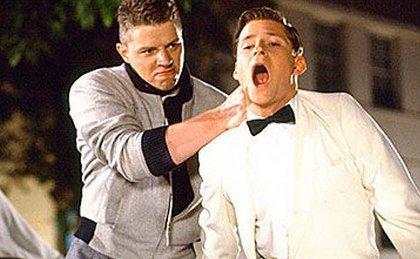
Gale and Zemeckis were adamant that they had something good, but after years of rejection, Zemeckis opted to take a break from peddling the project to direct Kathleen Turner and Michael Douglas in Romancing The Stone.
It was the best move he could have made for his time travel movie. When Romancing The Stone hit the big bucks, suddenly he could do anything he wanted. And want did Zemeckis want to do? Well, it just so happened he had a perfect time travel script sitting pretty in his top drawer…
There was only one last obstacle, which came in the form of Universal Pictures' executive producer Sidney Sheinberg, who brought some of his own ideas to the table.
First he changed McFly’s mother’s name from Meg to Lorraine (his wife’s name). That much was fine. But then he suggested changing the film’s title to Spaceman From Pluto. His argument for the change? No successful movie had ever had ‘future’ in the title.
Luckily, Spielberg knew how to handle such daft notions – he sent Sheinberg a note assuming that the new title was a joke, embarrassing Sheinberg into accepting Zemeckis’ original title.
Next: 1984 - "Wait a minute, don't I know you from somewhere?" [page-break]
1984 – “Wait a minute, don't I know you from somewhere?”
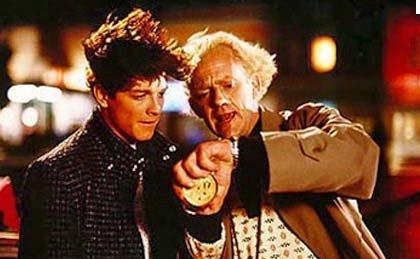
For young Marty McFly, Zemeckis knew exactly which actor he wanted. Unfortunately, Michael J. Fox was currently filming TV series Family Ties , and his producer wouldn’t give him any time off to shoot a movie.
“Michael Fox is a great actor, he’s got a fabulous sense of comedy timing,” says Zemeckis. “He looks perfect for the part. He’s an everyman. He’s accessible as an actor. He’s likeable. He’s funny.”
In perhaps one of the most famous Hollywood casting legends, Zemeckis instead opted for Eric Stoltz, whose schedule was less restricted, and who had impressed Zemeckis in the movie Mask .
However, disaster struck when four weeks into BTTF ’s shoot, Zemeckis realised that Stoltz was completely miscast. The actor wasn’t bad in any way, but crucially he wasn’t funny enough. Instead of playing up the comedy, he was taking a dramatic standpoint.
“Bob was cutting the movie as he shot it,” remembers Gale, “and he said to [ producer ] Neil Canton and me, after he screened 40 minutes of cut footage: ‘I think we've got a problem - I want you guys to look at it and tell me what you think.’
With Lea Thompson and Crispin Glover cast as Marty's mother and father, and Thomas F. Wilson in place as decade-spanning bully Biff, the movie was set to hit the restart button...
Next: January 1985 - "This is heavy" [page-break]
January 1985 – “This is heavy”
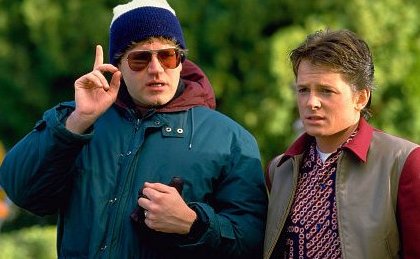
“The first day Michael worked after Eric Stoltz had been fired,” says Gale, is his favourite day on the BTTF set. “That first night [ Fox ] came on to the set. Just seeing how excited he was to be there and knowing that he really was Marty McFly.
“Watching him interact with Christopher Lloyd and the crew - he had this infectious energy. We were making one of the most difficult, riskiest decisions that you can make as a filmmaker - to replace your lead actor - and on that first night of shooting with Michael J. Fox we knew this was really good.”
Reshoots on BTTF began in early 1985, and it was a time that well and truly tested Fox. His commitment to both the movie and Family Ties meant that he was shooting the TV series during the day, and then BTTF between 6.30pm-2.30am. Somehow, he was surviving on five hours sleep a night.
Not that it mattered. For Fox, this was a dream project. “Things that appealed to me right away were, it was this teenage kid this guy rock n roll musician who liked to skateboard and chase girls, which was pretty much who I was,” he says.
Fox’s unwavering enthusiasm was welcomed by Lloyd, who had originally turned down the part before reading the script. “Michael was this kid with all that excitement and curiosity and energy,” he says. “And I remember coming off of that very easily.”
For the Courthouse Square scenes, a special outdoor set was created on the Universal Studios backlot. The set was dressed up in ‘50s garb for the time travel scenes, which would be shot first. The crew were then at liberty to destroy the set for the dreary modern day setting, shot last.
Meanwhile, various California locations lent themselves to the various scenes, with Puente Hills Mall in City of Industry standing in for the flick’s mall, while high school scenes were shot at the Whittier High School.
Next: July 1985 - "Whoa... Rock 'n' Roll" [page-break]
July 1985 – “Whoa... Rock 'n' Roll”

Shooting on BTTF wrapped on 20 April, 1985 after an impressive 100 days in front of cameras. With the release date set for August of that year (shoved back from its original May release), the race began to get the movie ready in time.
When a rough cut was put together, test screenings reaped a staggeringly positive response. The pressure was really on, though, when a test for executive Sheinberg was held at the supposedly cursed Hitchcock Theatre, which had never held a positive test screening.
Instead, the roof was nearly blown off the building, and Sheinberg approached Gale with a request: he wanted the movie in cinemas in July, not August.
In response, Zemeckis and his team got to work furiously editing material. Two editors were drafted in for the film, while sound editors often worked around the clock.
“The movie was in theatres nine and a half weeks after we wrapped principal photography,” marvels Gale “It was that close.
“We had two editors and we all knew what we were trying to do, and of course the movie was being cut all the time, while Bob was shooting it, so he’d go into the editing room on weekends and work with the editors on different sequences. That’s how tight it was, but we pulled it off.”
Next: 2010 - "Your kids are gonna love it" [page-break]
2010 - “Your kids are gonna love it”

It’s now the year 2010, and we’re just five years away from the futuristic setting (2015) that Marty and Doc Brown visit in Back To The Future Part II.
Since the film’s release, BTTF has become an adored classic, frequently appearing in Best Of lists the world over, officially selected for preservation in the United States National Film Registry by the Library of Congress, and adored by all generations.
Zemeckis always knew he had something special on his hands. “That’s the best screenplay that Bob and I ever wrote,” he says.
“Bob and I, this was the third picture that we had collaborated on, and we’d had wonderful previews on all our films,” Zemeckis adds, though those wonderful previews scared him, because all of his films had previewed well but not made much of an impact.
“I got very nervous when the previews were good because I had a movie that I knew the world would really enjoy seeing.”
Christopher Lloyd still has people associating him with Doc Brown: “It’s nice people come up and liked and enjoyed something you’ve done.”
Michael J. Fox, meanwhile, will forever be Marty McFly. Perfectly embodying the teenage everykid, he’s as timeless as the movie itself – a hero that everybody can associate with.
Now, Back To The Future is winging its way back into cinemas, re-mastered and ready to take on a whole new generation who’ve only seen it in pieces on ITV2.
“I hadn’t seen the movies myself until we re-mastered them,” Gale says. “I was actually amazed at how well they held up myself, and I think the reason is it’s basically just a human story. The idea that your parents were once kids is something that crosses all cultures, it crosses everything.
“When your kid suddenly comes to the realisation that mom and dad were once children, that’s such a big idea for a little kid to understand and make sense of. I think that’s the appeal; it just goes past all the other stuff.”
So what have we learned from Back To The Future ? “That you are in control of your own destiny,” says Gale. “It's all about personal responsibility. And just because somebody says that something is supposed to be a certain way, it ain't necessarily so.
“Doc Brown sums it up at the end of BTTF3 when he says, ‘Your future is whatever you make it, so make it a good one.’”
Welcome back Marty…
Like This? Then try...
Sign up for our free weekly newsletter here .
Follow us on Twitter here .
Josh Winning has worn a lot of hats over the years. Contributing Editor at Total Film, writer for SFX, and senior film writer at the Radio Times. Josh has also penned a novel about mysteries and monsters, is the co-host of a movie podcast, and has a library of pretty phenomenal stories from visiting some of the biggest TV and film sets in the world. He would also like you to know that he "lives for cat videos..." Don't we all, Josh. Don't we all.


